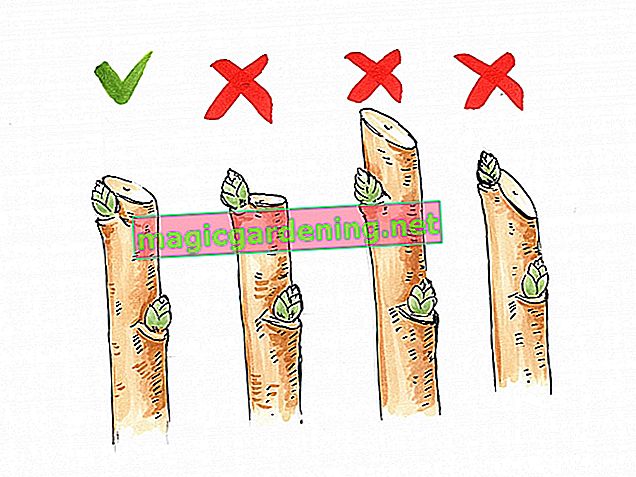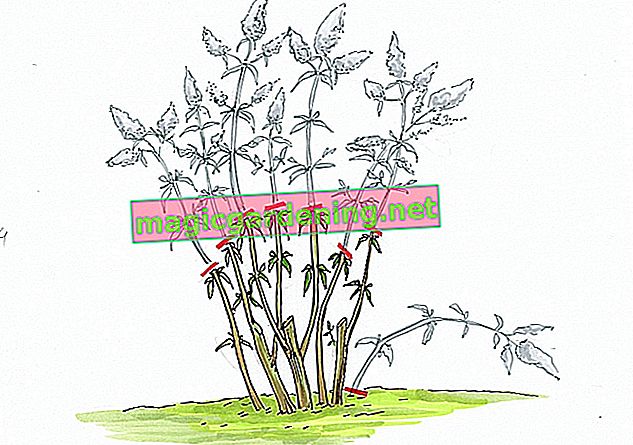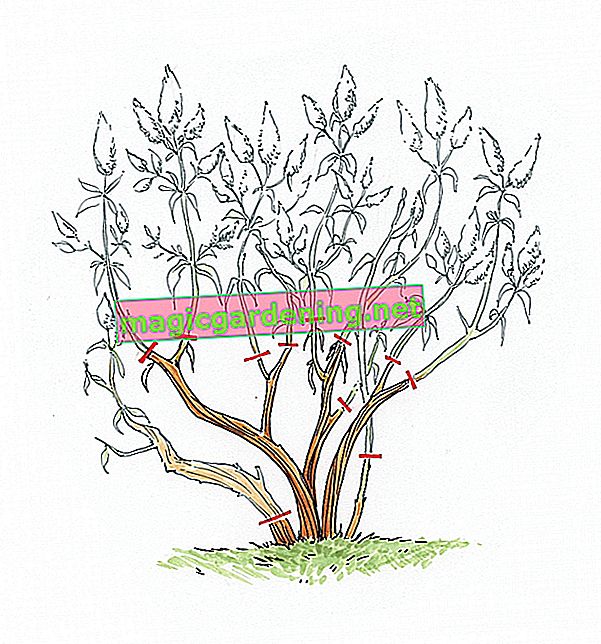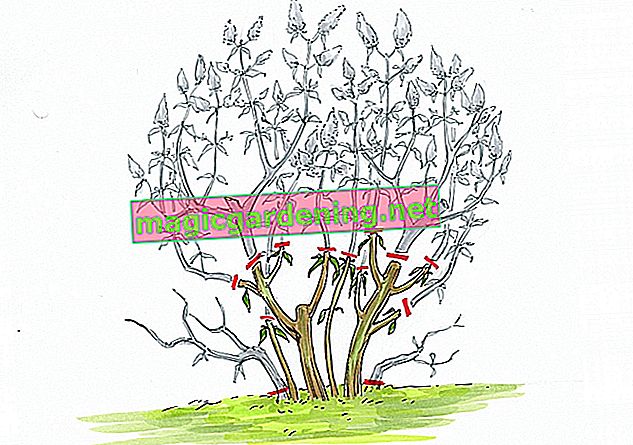
Tutorial content - informed answers to these questions
In order to learn the correct pruning of plants, you will not be spared a little reading. After all, you want to master the greatest challenge in wood care flawlessly. Studying this tutorial on cutting butterfly lilacs will be rewarded because by the end you will have mastered the answers to important questions in the truest sense of the word from the wrist.
- Which botanical factors influence the cutting result? - the cut profile
- How does a butterfly lilac grow? - Growth rules of the Buddleja davidii
- Big flowers or a neat look? - The cut controls the result
- When is the best time? - The choice of dates has an effect on the result
- Which equipment is really useful? - Recommendations for scissors & Co.
- How are scissors and saws to be used correctly? - The basics of the cutting technique
- How does the upbringing succeed? - step-by-step instructions
- How does the maintenance cut work? - step-by-step instructions
- How to deal with withered flowers - tips for cutting in between
- What to do with aged butterfly lilac? - Instructions for the taper cut
- Does wound treatment make sense or not? - Notes on follow-up treatment
- What can go wrong - The 3 most common mistakes when cutting butterfly lilac
also read
- Cutting the dragon tree correctly - tutorial for the perfect cut
- Exemplary cutting of a snowball - tutorial for the perfect cut
- Cutting trees correctly - tutorial for the perfect tree cutting
Facts relevant to cutting in a nutshell - the cutting profile
Skilled pruning is the supreme discipline of gardening. So it is hardly surprising that in hobby gardens there is uncertainty about when and how plants should be cut. A prime example is the butterfly lilac, which particularly benefits from professional pruning. The first step on the way to a routine cut is to know the most important influencing factors. The following profile gives you brief and concise information about all the relevant details as a basis for the perfect cut:
- Growth: deciduous shrub
- Height: 150 to 400 cm, dwarf varieties 40 to 60 cm
- Spread: 150 to 200 cm, dwarf varieties 40 to 60 cm
- Annual growth: depending on the species, 30 to 60 cm
- Flowering time: July to October, in mild locations from June to November
- Bud system: exclusively on this year's shoots
- Frost tolerance: hardy to - 20 degrees Celsius
- Cut tolerance: excellent
- Toxic content: slightly toxic
Later on, if you have doubts about when and how to prune your buddleia, keep these facts in mind.
Growth rules set the course - this is how butterfly lilac grows and blooms
If the gardener is familiar with the growth of Buddleja davidii, all uncertainties about the correct pruning vanish into thin air. As a typical summer bloomer, the butterfly lilac adheres to fixed rules that lead to a pruning care suitable for beginners. If you immerse yourself in the species-specific growth behavior, you will no longer have any doubts about the expert cut:
- Buddleja davidii only flowers on this year's shoots
- This year's shoots initially grow unbranched
- In the course of summer, short side shoots with smaller flowers sometimes thrive
- Uncut annual shoots branch out more and more from year to year to form non-flowering, dense bushes
- Two-year-old and older shoots only act as a framework for this year's flower shoots



It is characteristic of butterfly lilacs that numerous shoots grow from spring onwards. Buds only form from early summer and turn into large flower panicles from July. The number and vigor of young shoots is therefore directly related to the abundance of flowers. Wood from the previous year and old should not stand in the way of fresh budding. Consequently, a strong pruning in spring sets the course for a spectacular bloom festival of buddleia.
The objective defines the cut - what do you want to achieve?
With every cut you actively intervene in the growth of your butterfly lilac. Depending on the specific implementation, they cause a very specific effect in the bush. Are you aiming for a lavish flowering time with extra large flower clusters or are you aiming for a well-groomed appearance? Unfortunately, the growth behavior of Buddleja davidii described above does not allow both results at the same time, but rather presents you with a decision. These options are available:
- Profound pruning creates voluminous flower panicles up to 30 cm long
- A moderate cut creates a harmonious growth shape with a homogeneous crown
The later instructions for the upbringing and maintenance pattern concretize the close relationship between the pattern and the result.
Juice pressure controls the budding
Beginners in the pruning of Buddleja davidii are amazed that the desired growth result can be communicated non-verbally to the shrub with the help of the scissors. The answer is less mysterious than it might seem. The crucial component for the different results is the juice pressure. The connections in brief:
- The juices in the butterfly lilac always strive upwards
- The higher the position of buds on the shoot, the higher the sap pressure
- The juice accumulates minimally on the buds for optimal supply
- A cut changes the juice pressure at and below the cut
If you shorten a branch, the interface automatically becomes the new shoot tip. The sap pressure increases, whereupon a strong new shoot develops. At the same time, the number of buds to be supplied has decreased, which also intensifies the pressure. It follows that the more vigorous the pruning, the stronger the growth of shoots and flowers.
Time influences the result - tips for choosing the right date
As explained in the section on growth behavior, a butterfly lilac flowers only on this year's shoots. From this follows spring as the only sensible time for the upbringing and maintenance pruning. An exception applies to the rejuvenation cut, because with this measure the requirements of the Federal Nature Conservation Act have priority. The gardener sporadically or once in autumn devotes himself to withered flowers and the invasive urge to spread. The following overview clarifies the details:
| Schedule | education | conservation | rejuvenation | Spread control, winter preparation |
|---|---|---|---|---|
| Goal of the cut: optimal bloom abundance | Mid / end of February | Mid / end of February | ||
| Cutting goal: harmonious growth habit | Early March to early April | Early March to early April | ||
| Cut target: rejuvenation | from the end of January until February 28th at the latest | |||
| Aim of the pruning: Remove what has withered, prevent self-sowing | regularly | regularly | Maintenance cut in autumn |
Please make sure that it does not freeze or rain during the day itself. If your garden is in a region prone to late frost, keep a fleece close at hand to cover the freshly cut shoots overnight if necessary.
The specific date has an important influence on the strength of the shoot. The further the growth of your butterfly lilac has progressed in spring, the lower the sap pressure and the weaker the new shoots. For this reason, the above timetable refines the recommendations for the ideal editing date, tailored to the desired result. Act here according to the rule of thumb: the earlier the cut, the more vehement the subsequent growth and lush the abundance of flowers.
Prepare pruning professionally - recommendations for scissors & Co.
The tool occupies a key position in the series of important factors influencing the perfect cut. Please act according to the motto “Quality is the key”. The specialist trade has a wide range of high-quality scissors and saws that make cutting work on butterfly lilacs much easier. We recommend the following cutting tools as basic equipment:
- Hand scissors: for shoots up to 2 cm thick (available for right and left-handers)
- Pruning shears: for branches 2 to 4 cm thick (with long or extendable handles)
- Sword or folding saw: for removing more than 4 cm thick ground shoots
High-quality tools are not only easy to use. You can also easily take apart, clean and sharpen hand shears and loppers.
Bypass or anvil scissors?
The specialist trade offers two versions of garden shears (€ 15.99 at Amazon *) for one-hand operation: bypass and anvil shears. The distinction is often a headache for beginners in pruning. Our tutorial briefly deals with the outstanding distinguishing criteria so that you can select the right model for your butterfly lilac when you buy it:
- Bypass scissors with two sharp blades: the curved upper knife runs past the concave lower cutting blade
- Advantage: sharp cuts without fraying
- Disadvantage: higher effort
- Anvil scissors with sharp D-shaped blade and blunt anvil: the blade presses the shoot onto the anvil and cuts
- Advantage: better power transmission
- Disadvantage: Risk of bruising on hard wood shoots
The way anvil shears work is primarily suitable for cutting soft woods. Since Buddleja davidii thrives with extremely resistant, hard wood, bypass shears are the better choice.
The basics of cutting technique - this is how you cut butterfly lilacs like a professional
A clean cut guarantees that the pruning of butterfly lilacs will be a successful project. Use freshly sharpened and carefully cleaned scissors if you cut off the previous year's withered shoots in spring.
Place the blades just above a bud. If there are two opposite leaf buds, please cut away from both buds in parallel. Align the scissors at a slight angle so that the cut leads away from the bud or buds, as the sketch shows. It is important to note that at least one bud is directed outwards, because this determines the direction of growth of the shoot.
In order to clear out dead or too narrow ground shoots, place the loppers on the base. Since a fresh shoot is not to be expected at this point, all that matters is a smooth cut. Moving the scissors slightly at an angle ensures that irrigation water and rainwater run off better to protect against fungal infections.

What to do if the buddleia is sick
All rules of growth and pruning become waste when a buddleia becomes ill. If mealy-white coatings or yellow spots appear on the leaves, there is an urgent need for action. Regardless of the season, pruning is recommended as an immediate measure before you initiate further treatment to combat the disease.
Cut off all the diseased parts of the plant, as you learned in the basics of the cutting technique. It is important to note that you carefully disinfect the tool before and after cutting. The stubborn pathogens can easily hold out for weeks on scissors and saws in order to infect a previously healthy plant the next time they are used.
Tips
Cuttings from sick butterfly lilacs do not end up on the compost. The danger that the pathogenic agents will spread again in the garden is too great. If possible, you should burn the shoots and leaves. Alternatively, you can dispose of the clippings in the household waste.
Instructions for the parenting cut - how to do it right
In the first 5 years of standing, the upbringing pattern pursues important goals. A stable framework of older shoots forms the basis for the annual budding of vital flowering branches. The extent of the annual cut determines the abundance of flowers and regulates growth in height and width. That is how it goes:
- In the first 3 years, leave the strongest 3 to 5 ground shoots for the scaffolding
- Cut excess, meager and dead shoots close to the ground
- Cut back scaffold shoots in spring to a height of 30 cm
- In the 4th and 5th year of standing, the scaffolding shoots should grow 15 to 20 cm higher per year
- Every spring, shorten all side shoots on the frame to short cones with 2 or 4 buds
Cut young ground shoots in the 4th and 5th year back to a height of 30 cm. When the education cut leads to the maintenance cut, these ground shoots have an important task.

Instructions for maintenance pruning - pruning for a long plant life
In the spring of the 6th year, the training of the butterfly lilac is completed. Cut the shrub back by half to two thirds annually. The 3 to 5 ground shoots of the training phase are now outdated and lose their frost resistance. From now on, cut the oldest 3 scaffold shoots close to the ground every year so that young shoots can take over the task. In this way, a continuous rejuvenation takes place, from which vitality and abundance of flowers benefit.
Keep shortening the side branches down to 2 or 4 buds because this year's flower stems will sprout at these points. After a professional maintenance cut, all that remains of the butterfly lavender is the thinned frame with the short side stubs.
The more radical the conservation pruning, the more wasteful the summer bloom. However, with this year's long shoots, your butterfly lilac appears sparse and also offers no privacy. Proceed more cautiously when cutting, give the flowering shrub a well-formed, compact shape. To do this, vary the cutting heights by shortening some branches more and only cutting back other shoots by a third.

Frost damage to buddleia - what to do?
If a harsh winter leaves the butterfly lilac with significant frost damage, it is necessary to rethink the pruning. The main thing is to remove the dead, frozen back wood so that the way is clear for healthy budding. How to act correctly:
- Completely clear dead wood
- Cut frozen shoots back into healthy wood
- Fertilize the butterfly bush with compost and horn shavings, (€ 6.39 at Amazon *) to mobilize the growth forces
If you cannot visually recognize the transition from frozen to healthy wood, a vitality test will help. Scrape off a small piece of the bark and examine the tissue. Living tissue is light to green, whereas a dead shoot inside is brown.
Withdrawn is a case for scissors - tips for cutting in between
Withered flowers are a negative point on butterfly lilac in several ways. On the one hand, they affect the decorative appearance. On the other hand, withered flowers turn into fruits with a myriad of seeds that cause invasive spread. Last but not least, wilted panicles prevent the fresh buds underneath from growing, which noticeably shortens the flowering period. Consequently, everything that has withered is a case for secateurs. How to proceed properly:
- Regularly clean withered flowers
- Cut the tip of the shoot back to the next bud
- Shorten overhanging branches to a side branch
If you don't have time for continuous cleaning, we recommend autumn pruning. Cut off all withered inflorescences in one go to prevent the buddleia from self-sowing. Please limit the cut to everything that has withered up to a maximum of a third of the branch length, because the remaining shoots serve as natural winter protection.
Instructions for the rejuvenation cut - radically cut instead of clearing
The knowledgeable rejuvenation cut breathes new life into an old butterfly lilac. If you missed the maintenance pruning for a few years or inherited an old Buddleja davidii, don't be put off by the meager appearance. Radical pruning removes bald and dead shoots to make room for rebuilding. How to do it right:
- First thin out all dead shoots close to the ground
- Shorten outdated scaffold shoots to cones with at least one pair of buds
- Cut strong young shoots back to 30 cm and leave to stand as a replacement for scaffold shoots that no longer sprout
- The side branches on it intersect except for 2 buds
In the following years, rebuild the butterfly lilac by following the instructions for the parenting pruning.

Post-treatment optimizes the cut result - wound closure or not?
The sealing of cut wounds with wound sealants on trees has had its day. Modern research results show that shrubs, like butterfly lilacs, have self-healing powers. The interfaces are sealed off and overgrown on their own. Fresh wood forms above the sealing limit. Tree wax (€ 5.99 at Amazon *) hinders this process considerably. In most cases, wound treatment is not necessary after cutting the buddleia.
An exception applies to cuts that exceed half the diameter of the shoot. In spring there is a risk that shoots will dry out in such places and rot will form. To prevent this process, smooth the edges of the wound with a knife. Then spread a wound closure agent thinly on the edges. The wood core remains free for an unhindered supply of oxygen.
The 3 most common mistakes when pruning butterfly lilacs
The good-natured cut tolerance and the vital growth make the pruning of butterfly lilac easy. At the same time, there can be omissions that make the summer bloom sprinter difficult to cope with. The 3 most common mistakes with tips on how to avoid them form the end of this tutorial:
| The 3 most common mistakes | error | episode | correction |
|---|---|---|---|
| multiple cutting during the season | increased, broom-like shoots at the shoot tips, shedding at the base of the bush | Thinning out broom shoots, cut once in spring, do not cut too deep when cleaning out | |
| Shrub never thinned out | thick, entwined knots, aging from below | Thinning out dead wood every spring, also cut off the 3 oldest ground shoots from the 6th year | |
| too long stubs over the buds after cutting | Stubs rot and magically attract diseases and pests | always cut 2-3 mm above a bud in a slight oblique position |
Tips
A pruning out of order takes place when you transplant butterfly lilacs. The best time to change location is in autumn, which according to the program only provides for cleaning out withered flowers. Since a considerable amount of root volume is lost during transplanting, adequate pruning of the shoots will restore balance.








